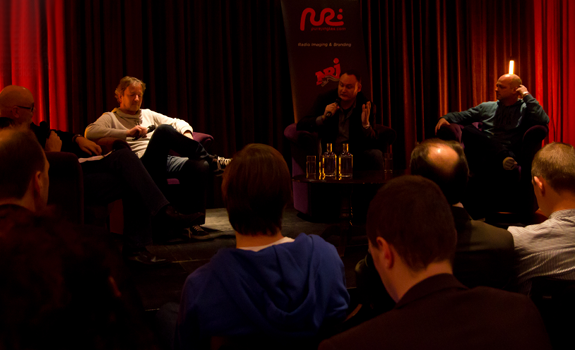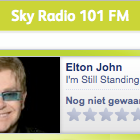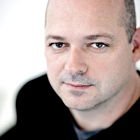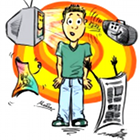Dutch radio programmers say that constant innovation, familiar brands and shared emotion are key to secure radio’s future in this (social) media world.
What will Radio 4.0 look like? was the topic of a visionary panel session at De RadioDag 2012, where program directors of the 3 biggest radio groups in Holland talked about the future of radio with interviewer Leo van der Goot. It looks like radio is becoming more than it’s been before: “We dropped the word ‘Radio’ at 538 for a reason.”
Uitilize radio’s accompaniment strength
“Radio has a tendency to die”, was Van der Goot’s opening statement – referring to the reincarnations of radio after the arrival of television in the 1950’s, digital sound carriers during the 80’s, the Internet in the 90’s, and social media during the first decade of this century. The fact that you can listen to radio while you’re doing something else is one of the reasons that it’s still so popular, according to program director Uunco Cerfontaine of the Sky Radio Group. He’s responsible for the output of Sky Radio 101 FM (Hot AC) and Radio Veronica (Recent Classic Hits).
“You can never stop innovating
when you’re in radio”

538 Groep content director Florent Luyckx (wearing white sweater) points out that even if your radio station is very successful, you have to constantly anticipate new developments and refresh your output (photo: De RadioDag)
Use social media (back)channels
PD Wilbert Mutsaers of Dutch public radio channels 3FM (CHR) and Radio 6 (Urban AC / Smooth Jazz) knows that this not only works well on a station basis, but also on a program level: people can interact with a radio show through social media while they listen to that show. Therefore, in his opinion, new media are a useful additional broadcast channel and feedback tool for established media, rather than a threat. “There is a lot of twittering and facebooking going on about things that happen in mass media.”
 Focus on immediacy & interaction
Focus on immediacy & interaction
His predecessor Florent Luyckx, now content director of 538 (formerly Radio 538) (CHR), SLAM!FM (Rhytmic CHR) and Radio 10 Gold (Oldie-based AC) which are all operated by the 538 Groep, speaks of a unique position for radio because the medium is always up to date. “This speed connects radio easily to the Internet.” As for interaction, he sees a lot of growth potential: “I think this two-way traffic is the ‘Radio 4.0’ that we’re looking for.”
Guarantee a user-friendly service
“Personal contact will become more important than the music”, he continues. “We focus everything that we do on the listener, and facilitate a conversation with the listener.” Is that a problem for ‘DJ-free’ Sky Radio? Uunco Cerfontaine doesn’t think so, because the station’s non-stop format is a USP within the Dutch radio market, ever since its launch in 1988. “Sky is an established brand that has a certain quality.” He sees their weekly reach of 3 million listeners as proof that many people still love simple plug & play: “Social media demand a lot from you, and sometimes you feel like it – but sometimes you don’t want it at all. Then you still love to press just one button and get something that fits your taste.” The fact that nowadays music can be quickly and easily found online, doesn’t mean that we should only focus on what happens in between the songs, is Wilbert Mutsaers’ opinion. He thinks that his station “3FM should support new Dutch songs and artists, and also look for the edges.”
 Optimize library music rotations
Optimize library music rotations
Of course, as PD of a publicly-funded station he has more freedom than his colleague Cerfontaine, who programs the privately-owned and “around 700 titles” spinning Sky Radio – adding that the number of songs in a database doesn’t say much. As half of the daytime playlist on is consisting of current music, classic hits have a low rotation. This way, Sky can make sure that it takes a while before people hear the same classic (at the same time).
Develop positive brand images
It’s a known fact that audience behavior is driven by listener expectations, and that perception is reality. Therefore, if and how long people tune into your station mainly depends on their impression of your station – your image – which is based on earlier listening experiences (and much less on what they’re hearing on your station right now). Sky Radio was hugely successful in the mid 1990s, when AC music was very ballad-driven. However, the image of being a Soft-Pop station became a disadvantage when the music cycle went into a different direction. “Sky got a little bit out of fashion”, Cerfontaine says about that. Why did the station see this coming, but didn’t intervene back then? “I think that in commercial broadcasting, you always have to deal with: as long as you make the targets, leave it as it is.”
 Keep innovating your station
Keep innovating your station
“These are the moments when you need a vision about where you want to be in 5 years from now”, says Florent Luyckx. He wants to anticipate, rather than catching up afterwards by making moves that can disorient the audience and damage the brand. “Actually, you can never stop innovating when you’re in radio.” One of the ways to do it, is to invest in talent development to find tomorrow’s radio personalities.
Choose the right talents
Wilbert Mutsaers is pleased with a new generation of talents that his station discovered and developed through its own 3FM Radio-DJ School. “A lot of young people that I have faith in, have been given a regular shift”. Uunco Cerfontaine has many established presenters from the 1980’s and 90’s in his line-up for Radio Veronica, which plays a lot of music from that era. He also gives fresh talents a chance, but notes that new presenters should always relate to the station’s target audience (in case of Radio Veronica: adult men, in their thirties and early forties). “If you’re twenty yourself, have no mortgage or family, and talk about Lowlands … my core listeners know what it is, but they’re not gonna’ camp there in a tent anymore.”
“The future of radio is a brand”

Sky Radio 101 FM and Radio Veronica PD Uunco Cerfontaine (left), on stage with Wilbert Mutsaers, thinks that radio should be offering a complete brand experience, rather than just being a radio station (photo: Thomas Giger)
Hire natural storytelling talents
Florent Luyckx’ main criterium for selecting radio talents is that they are natural storytellers. “There are people who kill a wonderful story by the way they tell it, and there are people who will turn a nice story into an amazing one because they’re great storytellers. That’s the sort of talent that we’re looking for.” To polish these rough diamonds, the 538 Groep has a talent training program called NUTALENT and, at the time of this writing, is preparing a digital radio station where talents can ‘build flight time’ and receive professional coaching as well.
 Evaluate entire radio output
Evaluate entire radio output
Wilbert Mutsaers thinks that our main job in this industry is to remain relevant. Innovation is crucial: “Make sure that you matter, and try new things. Radio is the best medium to embrace new developments.” He likes to apply innovation to the complete output of a station – from programming to marketing. “Have a look at your jocks. Is that the right team? Does your image match with the music that you’re playing?”
Build distinctive & familiar brands
For Uunco Cerfontaine it’s all about creating brands where people feel at home, through marketing and events. “That is the future of radio. It’s more than just a radio station; it’s a brand.” Florent Luyckx adds that you should create a recognizable brand, so your audience knows what to expect. “This goes beyond music. It’s all about a shared feeling. We dropped the word ‘Radio’ at 538 for a reason – to create a brand around it that you will encounter everywhere, in different forms, and that we’re able to market very easily.”
 Realize radio isn’t alone
Realize radio isn’t alone
Luyckx realizes that as there are more and more media, fragmentation is increasing: “The impact of mass media remains to be strong – they are trusted brands, that you keep looking for – but their effectiveness diminished a bit.” He explains radio listeners are also being influenced by several other media (not in the last place, social media). “The days that you could ‘educate’ your audience by what you thought is the best music are gone.”
Become music’s biggest fan
“There is a comma after that”, says Mutsaers, who has been creative director at Universal Music in the Netherlands before becoming 3FM PD. Now that the music industry’s marketing impact has declined – record companies are not the only jumpstart for talent anymore – he sees an opportunity: “With radio and social media combined, you can create an enormously important and fun place by actively supporting new music.” Cerfontaine cites Nielsen’s Music 360 Report from 2012, showing that music discovery is still dominated by radio. (But, according to the same study, teens turn more to YouTube than to the radio to find new music!)
 Partner with car factories
Partner with car factories
Does investing in DAB still make a lot of sense – or is mobile IP the future of radio? Cerfontaine finds it positive that DAB will make room for more stations and improve their coverage. But the successful introduction of digital radio depends on the automobile industry: “If it’s installed in cars by default, it may still thrive.” Luyckx sees DAB as an “intermediate” solution, as long as online distribution is constrained by limited bandwidth and expensive data traffic.
Be listener’s life connection
The panel of program directors sees an overall bright future for radio. “Of course there are threats, but that has more to do with money and market shares,” according to Wilbert Mutsaers. “The technology and content behind radio offers all the possibilities in the world. Radio is now; is live; is fast.” Final conclusion is that radio brands will remain to thrive on emotion and a personal relation with the audience – or, as Florent Luyckx describes it: “Radio connects you to the world. That’s an ironclad promise.”
Stay tuned, follow us @RadioILOVEIT and click below to share this post:





Add Your Comment